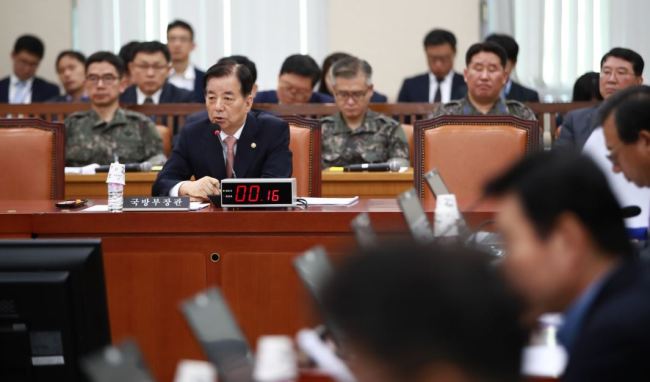South Korea's defense ministry on Wednesday confirmed North Korea's test of a new intercontinental ballistic missile, identifying it as an upgraded two-stage version of its KN-17 or Hwasong-12 missile.
During a parliamentary briefing, Defense Minister Han Min-koo said that the ministry put the missile's range at between 7,000 kilometers and 8,000 km but found no definitive evidence to prove its atmospheric re-entry capability.
The minister also noted there is a "high" possibility of Pyongyang staging another nuclear test and that its capability to miniaturize a warhead has reached a "considerable" level.
"If the North Korean regime presses ahead with reckless provocations, it would face stern sanctions from the international community and, in the end, its self-destruction," Han told a session of the National Assembly's defense committee.
"We are keeping close tabs on the North's movement in close cooperation with the US (forces) and preparing -- based on the South Korea-US alliance -- to respond sternly to any provocation," he added.
 |
Han Min-koo (Yonhap) |
After launching what it calls the Hwangsong-14 missile earlier Tuesday, the North claimed it succeeded in its first ICBM test, with the missile reaching a top altitude of 2,802 kilometers before splashing into the East Sea, some 933 km away from the launch site.
During the briefing, Seoul's ministry refused to conclude the North succeeded in developing an ICBM.
"Considering that the missile was launched from a fixed launch pad, and that we have yet to confirm whether (the missile) has re-entered (the atmosphere), there are still limits for us to conclude that the North has been successful in its ICBM development," the ministry said in the briefing.
As for the reason why the North used the fixed land-based launch pad, the ministry said it was a temporary method at a research or development phase and appeared intended to avoid damage to its road-mobile launchers.
For the North to claim its latest test as a success, Han said Pyongyang must prove the missile warhead is capable of withstanding temperatures of at least 7,000 degrees Celsius.
"What matters is whether its warhead functioned well from a military standpoint when it re-entered the atmosphere after flying into space," Han noted.
The minister also noted the "high" possibility of Pyongyang carrying out another nuclear test. The North has a track record of conducting nuke experiments following long-range rocket tests.
"It is hard to conclusively talk about (the possibility), but I think the likelihood is high given that (becoming a nuclear power) is the North's national goal," he said.
The North's missile provocation has strengthened the rationale for stronger missile defense.
Han defended the deployment of the US THAAD anti-missile system as the "best" defensive weapon to counter threats from Pyongyang's short- and mid-range missiles. But he admitted it was not designed to intercept an ICBM.
Referring to Wednesday's ballistic missile exercise jointly staged by South Korea and the US, the minister pointed out that it was the first allied drills in response to the North's missile launch.
Commenting on the North's intentions behind the latest provocation, the ministry pointed out its development schedule based on its technological motive to secure long-range delivery capabilities, a show of force following the South Korea-US summit last week and ahead of the US Independence Day, and its intent to secure an upper hand in future negotiations with South Korea and the United States.
Meanwhile, the parliamentary committee adopted a resolution condemning the North's missile launch and urging it to stop any escalatory activity.
"The North Korean authorities themselves will have to bear the price for their provocative behavior, and we gravely warn that it could result in the Kim Jong-un regime facing its collapse and extinction," the resolution read. (Yonhap)






![[Today’s K-pop] Blackpink’s Jennie, Lisa invited to Coachella as solo acts](http://res.heraldm.com/phpwas/restmb_idxmake.php?idx=644&simg=/content/image/2024/11/21/20241121050099_0.jpg)
